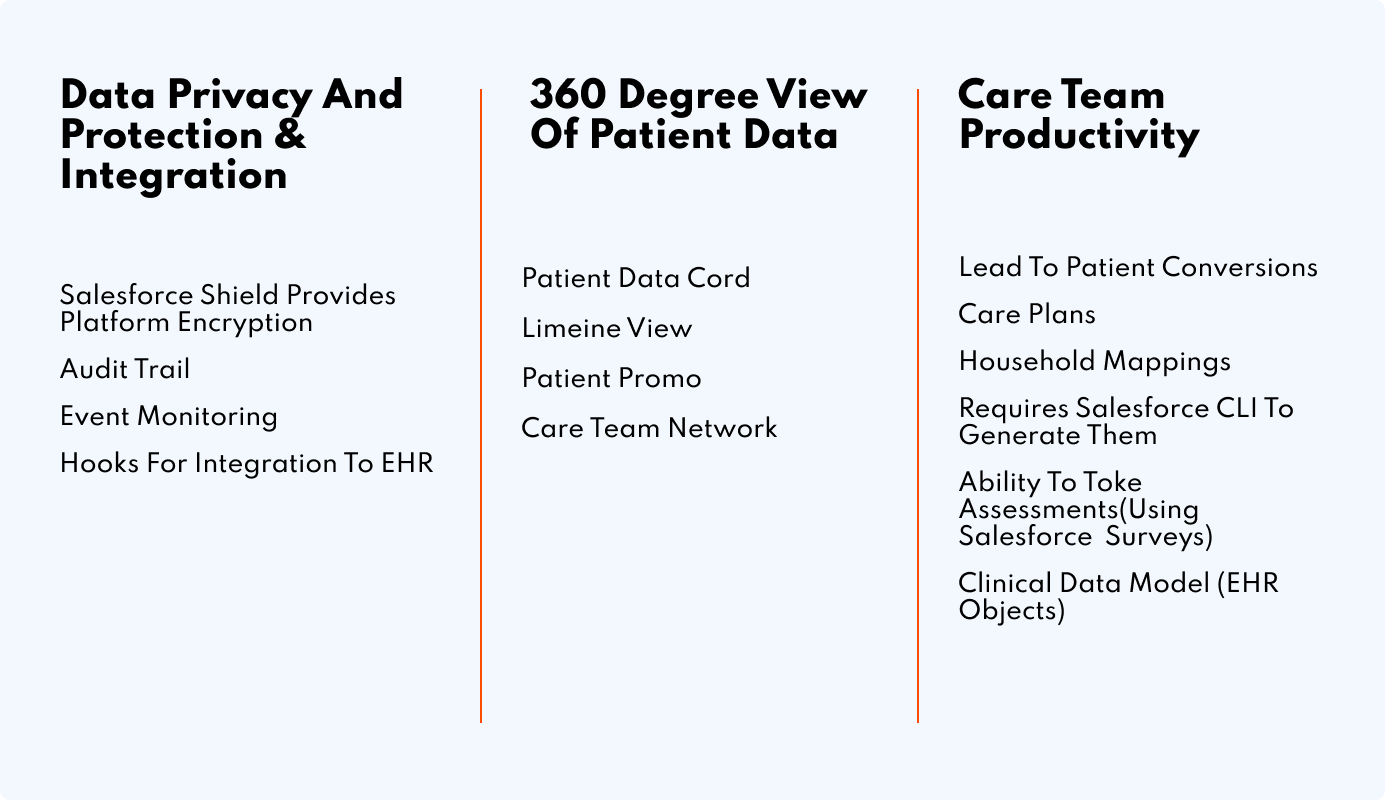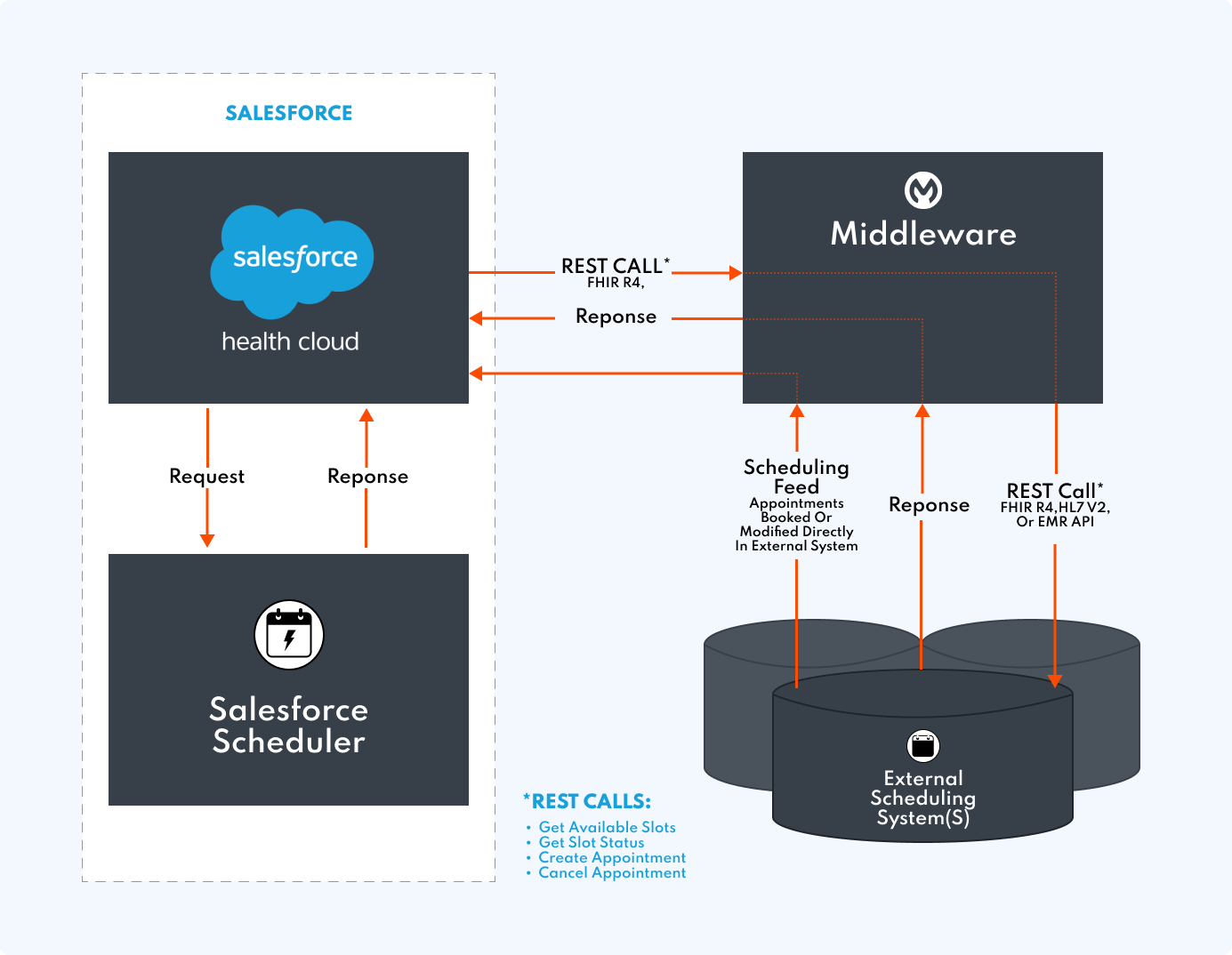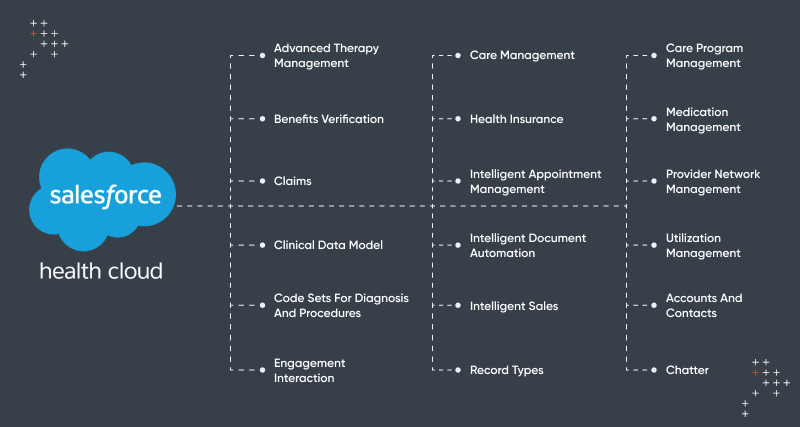Introduction
Salesforce Health Cloud is an industry product built specifically for the healthcare sector. It is regarded as the #1 healthcare CRM with four core capabilities.
- Enabling healthcare professionals to collaborate more efficiently
- Building 1-to-1 relationships across entire care journeys by providing in-depth insight into patients
- Providing easy access to essential functionalities for payers
- Unlocking data from legacy systems of records and EHRs (Electronic Health Registries) by using data models
These core capabilities help generate a 360-degree relationship between patients, doctors, and healthcare institutions. Salesforce Health Cloud can help healthcare institutions boost employee productivity, reduce inventory cost, accelerate patient engagement, increase growth, create better digital experiences, and magnify scalability when used correctly and to its full potential.
But how can you utilize Salesforce Health Cloud Capabilities to grow your organization?
Read more to learn about the features and architecture of Salesforce Health Cloud that will help your organization exponentially boost scalability and growth.
Salesforce Health Cloud Features
Salesforce Health Cloud provides three primary feature sets, including:
Data Privacy, Protection, And Integration
Salesforce Shield consists of Shield Platform Encryption, Event Monitoring, and Field Audit Trail. It is an integral part of the Salesforce DXP and is a trusted group of security tools that helps developers and admins build security into important apps.
These tools ensure that all patient and user information is entirely secure. It also allows easy integration with patients' electronic health records to keep them engaged in their care.
This capability was utilized by the Health Service Executive (HSE), responsible for providing Ireland's public health and social services. The organization recognized the need to move to a composable and flexible platform before the start of the pandemic. The technical changes implemented by adopting Salesforce Health Cloud allow the HSE team to stay data compliant, solve COVID-19 vaccination challenges, and deliver a modern patient experience.
360-Degree View Of Patient Data
With Salesforce Health Cloud, healthcare professionals can access a 360-degree view of patients, including patient profiles, health records, timeline views, and treatment plans. This saves time by eliminating the hassle of toggling between screens and platforms. And can also help improve healthcare digital experiences.
Novartis, a Swiss-based multinational pharmaceutical company, lacked the modern architecture and capabilities to continue meeting its accelerated patient engagement goals. As a solution, a switch from legacy systems to Salesforce Health Cloud was implemented to create a highly composable, multi-channel, and multi-stakeholder patient engagement platform.
This platform provides deep insights into the patient journey and enables easy implementation of care programs. Read more to learn how the implementation was done.
Care Team Productivity
Care teams must constantly offer a high level of patient care and do more in less time. Health Cloud helps reduce this load by providing access to innovative applications. For example, household mappings offer more insight into a patient's home life, needs, and goals to help care teams provide tailored patient care. Care teams can also use Salesforce surveys to gauge if the team is providing the right support to the patients.
Capital District Physicians' Health Plan (CDPHP) is a not-for-profit, physician-founded, and guided health plan provider with 400,000 members and 825,000 providers. CDPHP utilized Health Cloud’s capabilities to create a connected system for health and marketing data to personalize campaigns, gain better marketing insights, and increase trust with all parties involved.

Salesforce Health Cloud Architecture
The external appointment management system from Health Cloud is part of a larger electronic health records (EHR) system. It can be integrated directly or via integration middleware like Mulesoft. The system required the following to manage appointments.
- Identifying the time slot support of the source system
- Implementing the Health Cloud global interface
- Modifying input requests to fit the source EHR system
- Routing the request to the EHR system
- Getting the appointment information back
The Provider data model uses the getProviders() call to filter and show providers in the UI. REST callouts from Health Cloud point to the source system of truth for availability and booking of appointments.
Organizations can also provide the Apex class and integrate it with their appointment management system. This can be done if the default REST endpoints by Health Cloud are unsuitable for their context. All appointment scheduling requests are sent to the external system. Health Cloud does not persist provider availability or replace the existing systems.
The external appointment management system manages all information about the healthcare provider's availability. And the ultimate authority on appointment status also lies with it. Named Credentials, which is a Salesforce platform, can be used to configure the endpoint base URI and authentication.

A Short Tale
Nucleus Research is an independent multi-specialty physician and minimally invasive treatment group that utilized Health Cloud’s architecture to improve its:
- Data and information management
- Provide unified visibility of data and communication
- Cross-team collaboration
- Maintain high-level of data traffic
In less than three months, Nucleus Research realized a 459% return on investment and saved over $500,000. The organization also experienced other benefits like improved employee productivity, reduced inventory cost, and elimination of legacy solutions.
Salesforce Health Cloud Data Model
The Salesforce Health Cloud provides a wide variety of standard and custom data models to store and access specialized health information. Some of these different data models are:
Advanced Therapy Management
Advanced Therapy Management helps streamline complex procedures in creating multiple appointments across different locations. The multi-step scheduling solution allows easy scheduling of appointments for users.
Benefits Verification
The Benefits Verification data model supports service providers, payers, and life science organizations in determining benefits covered under various services and products.
Care Management
Access to clinical data is critical to planning, executing, and managing patient care plans. The Care Management data model makes it easy to integrate clinical data with Salesforce using standard APIs. APIs allow quick mapping of messages from EHR systems into Health Cloud objects and fields.
Care Program Management
The Care Program Management drives increased adherence and improves patient outcomes. It represents a set of activities like financial assistance, education, wellness, or fitness plan offered by an employer or insurer.
Claims
A claim is an information submitted to an individual's health insurance company. This is done by the organization providing a service, medication, or device.
Clinical Data Model
The Clinical Data Model enhances Health Cloud by making it more interoperable. This model is built entirely on the core and is the successor to the original EHR Data Model.
Code Sets For Diagnosis And Procedures
The Code Sets data model represents industry-standard procedures and diagnosis codes used in prior-authorization requests and approval processes. These codes are imported using Data Loader.
Engagement Interaction
The Engagement data model stores details about any interaction between a patient, their authorized representative, or a contact center agent (CCA).
Health Insurance
The Health Insurance data model manages how care is paid. It represents information like employment, insurance coverage, and dependents. Members can manage these details.
Intelligent Appointment Management
Health Cloud provides a patient appointment booking experience in Salesforce by integrating with a customer's appointment management system. This can also be done for call center agents and care coordinators.
Intelligent Document Automation
The Intelligent Document Automation data objects simplify the document management process. It reduces requirements for manual data entry and manages all patient and member forms in a single place.
Intelligent Sales
With Intelligent Sales, sales teams can plan and execute various sales visits and manage field inventory.
Medication Management
The Medical Management data model enables care coordinators and clinicians to perform medication reconciliation and medication therapy reviews for patients. The data model provides objects for managing information on medication recommendations and comprehensive medication reviews conducted for patients.
Provider Network Management
Provider Network Management allows health insurance companies to onboard providers into their networks. It provides objects for managing provider applications and credentialing data to ensure patients can find the right care.
Utilization Management
Utilization Management (UM) provides objects that can be used to review and evaluate medical care services. It helps communicate clinical policies and ensures patients get the required care at the right time in the right setting.
Accounts And Contacts
Salesforce Health Cloud prominently uses Person Accounts to record information about a patient.
Record Types
Record types help differentiate between regular sales deals from professional services engagement. It enables value-based critical care. There are different record types, including:
- Lead: These are people who make inquiries or appointments, equipment providers, and other individuals who are part of the healthcare ecosystem.
- Person Account: These are records of individuals who are part of the system, specifically patients. When a lead enters the system, a personal account is created with the same name.
- Care Plan: It documents a patient's history, including progress and challenges. Healthcare providers can quickly get a comprehensive view of the patient’s problems, goals, and tasks through a care plan.
Chatter
Chatter enables meaningful communication. It makes care coordination for the patient easier and more efficient. It enables physicians and other medical professionals to discuss and manage care as a private group without involving an external care team.
Utilizing The Salesforce Health Cloud Capabilities For Your Organization
Salesforce Health Cloud is one of the most comprehensive CRMs created for the healthcare industry. It enables highly personalized interactions, EHR connectivity, cross-team collaboration, and more.
The customizable components of Health Cloud also allow medical organizations to create personalized community sites, Lightning apps, and Lightning record pages. Salesforce Health Cloud provides organizations with the power and resources that enable stakeholders to provide tailored healthcare experiences.
This power can be utilized by employing the right Salesforce development and deployment methodology. Contact the experts at Axelerant to learn about Salesforce Health Cloud capabilities and how you can employ it to generate results for your organization.

Abhishek Tripathi, DXP Consultant
Abhi likes to contribute to society, learns new skills from Trailhead, and when away from his desk, he spends quality time with his kids and helps out his wife and mother. When engaged, challenged, and appreciated at work, he’s unstoppable.

Simran Sethi, Content Marketer
Simran is an avid reader. She is an active runner, who also likes to swim, dance, and sing. For her, the meaning of life lies in the little things. Kindness, passion, and compassion are her life’s essential values.

 We respect your privacy. Your information is safe.
We respect your privacy. Your information is safe.



Leave us a comment